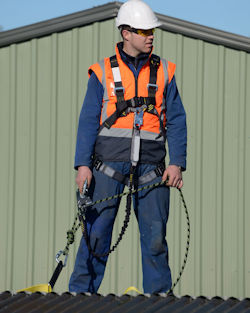Fall Restraint Systems
Fall restraint systems prevent the user from falling any distance. To determine the force needed to restrain a worker, consider the force that would be generated by the worker walking, leaning, or sliding down the working surface. The system consists of a body belt or harness, an anchorage, connectors, lanyards, lifelines, and other devices.
For a restraint system to work, the anchorage must be strong enough to prevent the worker from moving past the point where the system is fully extended, including an appropriate safety factor.
OSHA has no specific standards for restraint systems, however, in a 1995 letter of interpretation, OSHA suggested that, at a minimum, fall restraint systems should have the capacity to withstand at least 3,000 pounds of force or twice the maximum expected force that is needed to restrain the worker from exposure to the fall hazard.
Positioning Systems
OSHA defines a positioning device system as a body belt or body harness system rigged to allow a worker to be supported on an elevated vertical surface, such as a wall, and work with both hands free while leaning.
- Body belt or body harness systems are to be set up so that a worker can free fall no farther than 2 feet. 29 CFR 1926.502(e)(1).
- Body belts or harnesses must be secured to an anchorage capable of supporting at least twice the potential impact load of a worker’s fall or 3,000 pounds, whichever is greater. 29 CFR 1926.502(e)(2).
Scenario
While sitting or kneeling on a fixed deck plank attached to a fabricated frame scaffold, a worker was pulling a 16-foot 2x4 off the bucket of an excavator. There were no guardrails at the working level. When the other end of the 2x4 slipped off the bucket, the employee did not let go of his end, and was pulled off the deck. He fell 16 feet to the ground, sustaining facial fractures and other injuries.
Knowledge Check Choose the best answer for the question.
4-5. Fall restraint systems should have the capacity to withstand _____ of force or twice the maximum expected force.
You forgot to answer the question!

